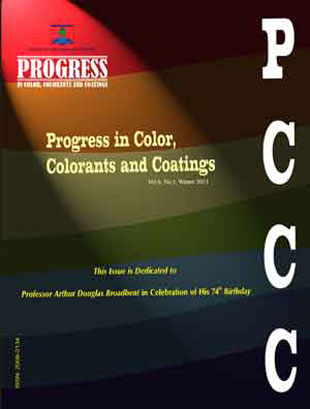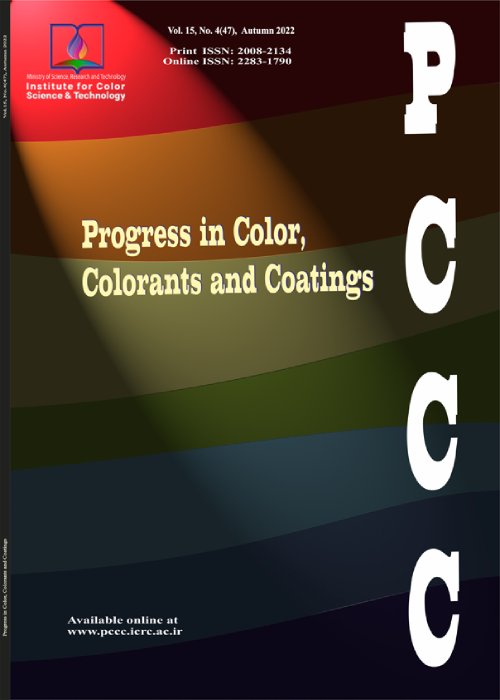فهرست مطالب

Progress in Color, Colorants and Coatings
Volume:7 Issue: 1, Winter 2014
- تاریخ انتشار: 1392/07/01
- تعداد عناوین: 7
-
-
Pages 1-9Anumber of polycarboxylic acids (butane tetracarboxylic acid (BTCA), polyacrylic-co-maleic acid (PAMA), citric acid, maleic-itaconic (MAIA)) were examined in combination with sodium hypophosphite(SHP)in order to give a similar high fabric crease recovery performance and whiteness index to traditional formaldehyde based crease agents. BTCA showed to be the best crease resist agent for crosslinking cotton fabric with SHP. In addition, BTCA treatment offers higher tear/ tensile strength compared to fabrics treated with dimethylol dihydroxyethylene urea (DMDHEU). FTIR/FT-RAMAN spectroscopies showed the presence of intermolecular ester crosslinks in cotton fabrics treated with BTCA. Treatment of Jarosol solubilised sulfur dyed cotton fabrics with PAMA/BTCA and SHP resulted in a color change of dyed fabrics because of the reductive nature of SHP. Jarosol solubilised sulfur dyed cotton fabric treated with BTCA/PAMA improved wash fastness due to dye locking inside the fibres, but light fastness didnot change.Keywords: Cotton, Crosslinking, Spectroscopy, Sulfur dye, Polyacrylic, co, maleic acid, Butane tetracarboxylic acid
-
Pages 11-18Organic modified polysiloxanes are generally recognized as the newest generic class of high performance protective coating and now widely used in new construction, heavy duty OEM, marine and industrial maintenance painting. A series of polymer–clay nanocomposite (PCN) materials that consist of siloxane-modified epoxy resin and inorganic nanolayers of montmorillonite (MMT) clay has been prepared through a thermal ring opening polymerization using 1,3-bis(3-aminopropyl)-1,1,3,3-tetramethyldisiloxane as a curing agent. Dispersion of nanoclay in these coatings was prepared by ultrasonication method. The mechanical properties of the nanocomposite coatings such as abrasion, hardness, adhesion and weathering resistance were increased by addition of nanoclay montmorillonite. Stability and morphology of the nanocomposite coatings was evaluated by TEM, XRD and optical microscope. The results showed a stable dispersion of clay layers in the matrix and higher dry and wet adhesion in comparison with pure epoxy –siloxane coating.Keywords: Epoxy siloxane, Nanocompasite, Salt spray, Adhesion, Abrasion, Hardness
-
Pages 19-26The purpose of this study was to investigate the effect of the structure of reactive dye on cotton ink-jet printing. Cotton fabric was printed upon with three commercial cellulosic reactive dyes, which are based on the similar chromophore and possess different numbers of reactive and anionic groups. Colour yield and absorbed dye fixation of the printed cotton were evaluated at various pH values. The ink-jet printing was carried out on a HP DeskJet 5150 printer at 1200 dpi, and then the printed cotton fabrics were air dried and put into a steamer to fix the reactive dye on to the cotton fabric. The results indicated that the absorbed dye fixation levels increased by decreasing the numbers of anionic groups and appeared to be dependent on the number of the reactive group. All reactive dye based inks are demonstrating excellent colour fastness to washing and dry/wet crocking. The light fastness of each reactive dye based ink fixed to cotton fabrics was moderate.Keywords: Reactive dye, Anionic, Cotton, Ink, jet, Printing
-
Pages 27-38The acid dyes are one of the most widely used commercial dyes used in the textile industries. This work investigates the ability of magnetite nanoparticles functionalized with imidazolium based ionic liquid as an efficient sorbent for removal of the Acid Blue 113 from wastewater. Fourier Transform Infrared Spectroscopy (FT-IR), X-ray diffraction (XRD) and Transmission Electron Microscopy (TEM) were used to characterize the synthesized nanosorbent. The results showed that under optimal conditions, the dye removal efficiency of the supported ionic liquid is 98.6% after a single run. The isothermal data of AB113 sorption conformed well to the Langmuir model and the maximum sorption capacity of IL@Fe3O4 for Ab113 was 92.59 mg g-1. Regeneration of the used sorbent could be possible and the modified magnetic nanoparticles exhibited good reusability. The use of such a system can provide fast and efficient removal of the acid dyes from wastewater by using an external magnetic field.Keywords: Magnetic nanoparticles, Ionic liquids, Acid Blue 113, Dye removal
-
Pages 39-48The interactions between an anionic dye, Acid Green 25 (AG) and the two cationic surfactants tetradecyltrimethyl ammonium bromide (TTAB), and hexadecyltrimethyl ammonium bromide (CTAB) in aqueous solutions far below the CMC are studied using the conductometric method at different temperatures. The equilibrium constants and other thermodynamic functions for the process of dye-surfactant ion pair formation were calculated using the conductometric data. The results showed that the surfactant with the longer hydrophobic chain had a stronger tendency to associate with the dye and the equilibrium constant was considerably higher than those measured for the surfactant with the shorter hydrophobic chain. These results indicate that short range, non-electrostatic interactions have a significant influence on dye - surfactant ion pair formation as well as long range electrostatic forces.Keywords: Cationic surfactants, Anionic dye, Ion pair, Equilibrium constant, Conductometry
-
Pages 49-60Dyeing properties of modified polyethylene terephthalate with a polyesteramide hyperbranched polymer (HP) were investigated in terms of their thermodynamic parameters, including standard affinity (-Δμo), enthalpy change (ΔHo) and entropy change (ΔSo). Results were then compared with corresponding properties of the virgin PET. The results showed that the isotherms were similar to that of virgin PET following as linear isotherm. The standard affinity of the dye to the modified samples showed higher value than that of virgin PET. The standard affinity of dye to the PET increased by the content of HP. The bath containing virgin PET displayed the highest negative values of the ΔHo and ΔSo, while that of the PET with 2% HP showed the lowest negative value. The surface structure and thermal behavior of the samples were determined by FTIR and DSC, respectively. DSC tests showed that the crystallinity and glass transition temperature of samples were decreased.Keywords: Hyperbranched Polymer (HP), Thermodynamic parameters, Polyethylene Terephthalate (PET) fiber, Dyeing, Disperse dye
-
Pages 61-72Two sets of opaque water-based acrylic coatings were prepared with IRreflective pigments and conventional pigments. The objective of this work was to determine the efficiency of IR-reflective pigments in limiting the heat buildup of opaque coating formulations. Experiments performed on PVC substrates revealed that IR-reflective pigments significantly decreased the temperature increase above room temperature. A similar behavior was observed for coating formulations applied onto white pine substrates. The temperature increase difference between the two sets of pigments was found to be lower with white pine, which is a better insulator than PVC. Prog.Keywords: Total solar reflectance, IR, reflective coatings, Acrylic Coatings, Heat buildup, Spectral reflectance


